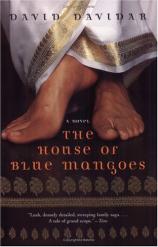Reading Group Guide
Discussion Questions
The House of Blue Mangoes

1. The first scene in the novel -- the rape of a young girl -- takes place on the tarred road that runs "like a fresh scar" through the village of Chevathar. Solomon Dorai blames the road itself for the crime, as well as for other unrest plaguing his village. What does this road represent? What other roads figure prominently in the novel, and why?
2. After the rape, Solomon's wife, Charity, visits the family of the girl who was raped, to see if there is anything she can do to help. But, as she discovers, "There's nothing [she] can do…There was no terrible spill of anger here, none of the fury that drove the mythical Kannagi to burn up her tormentors. This was different, more practical, perhaps the only way left to the women of the village. There was good and evil, and both were necessary to keep the world in balance -- you raged against fate only when you didn't understand. It was best to accept and go on." (40-41) What do you think of this philosophy? Why doesn't it work for Aaron? To what extent do Daniel and his son, Kannan, rage against their own fates?
3. How do Solomon, his sons Daniel and Aaron, and his grandson Kannan each represent their respective generations with regard to culture and political climate? How does each character precipitate change in his family, and in the Dorai clan?
4. Likewise, how do Charity, Rachel, and Helen represent their respective generations? In a country that denies women many of the freedoms enjoyed by men, what kinds of influence do these women wield? How do they obtain their power?
5. Throughout The House of Blue Mangoes Davidar reminds us -- in stunning detail -- of India's natural beauty and fierce climate. What role does nature play in the novel? What kinds of struggles do the characters wage against India's natural forces?
6. Like many other Indian clans, the Dorai family blends Hindu and Christian traditions. What are some of the results of this fusion? How does religion influence their lives? Can you think of ways in which your own religious beliefs reflect your family history and your environment?
7. Daniel's interest in siddah medicine leads him to a career as a physician, but he makes his fortune selling the popular skin-whitening cream he created. What does Daniel's success say about the British influence in India? How does his life embody both cultures?
8. Why is the scene in which Kannan hunts the tiger with Harrison important to the novel? Why do you think Harrison let Kannan live? Why did the incident convince Kannan that he needed to return to Chevathar?
9. How does Davidar use the mango as a metaphor for India and for the Dorai family?
10. Compare the novel's portrayal of Solomon in the first few pages with the final scene in which Kannan contemplates a mango he has just picked from the grove in Chevathar. How has Chevathar changed, and how has it remained the same? How do these scenes embody the novel's major themes?
11. Based on the novel's version of historical events, do you think India would have been better off without English rule? Give examples that support either argument.
The House of Blue Mangoes
- Publication Date: March 1, 2003
- Genres: Fiction
- Paperback: 432 pages
- Publisher: Harper Perennial
- ISBN-10: 0060936789
- ISBN-13: 9780060936785






